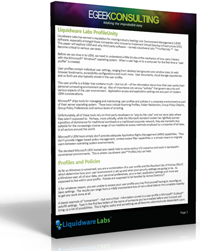Controlling how users access their desktop resources, including applications and data has become ever more difficult. Microsoft Roaming Profiles and basic profile tools are neither sophisticated or secure enough to provide comprehensive User Environment Management for today's enterprise Windows deployments. Many organizations rely on hundreds, or even thousands, of applications across their enterprises that are accessed by diverse groups of users who can be dispersed geographically and working on a variety of different devices across both physical and virtual and -- now-- cloud platforms. Most applications are personalized by users with custom spell checker dictionaries, email signatures, plug-in settings, etc. Today's dynamic workforce and compliance regulations also demand that user settings and policies follow users and adapt to differing work modes and devices, based on unique attributes with secure context-aware capabilities. 
The eGeek Consulting (link deleted) outlines how ProfileUnity addresses the Top Three Challenges in managing users on Windows desktops.
ProfileUnity goes beyond just profile management and offers sophisticated User Environment Management (UEM) features to allow Administrators to easily create and deploy rules about users interaction with their desktops and applications. ProfileUnity can recognize the "context" of when, where and how users are logging on in order to either allow or curtail access to desktop components (such as local printers and peripherals) or applications. This granular control allows Administrators to enhance user productivity, yet strictly maintain security policies.
ProfileUnity's UEM features include:
- Direct Integration with Active Directory allows Administrators to retrieve information from domain controllers about current users' accounts. Advanced aliases require an Active Directory infrastructure and ADSI support on your clients. The values retrieved are available for use throughout your configuration.
- Application Rights Management which enables administrators to securely modify and/or elevate "standard user" rights in Windows to allow or deny applications from being executed, delivered, or installed on select users’ desktops. Application Rights Management is included within the ProfileUnity User Environment Management feature set for no extra cost, adding great value for organizations.Two feature modules within ProfileUnity enable organizations to accomplish Application Rights Management: (1) Privilege Elevation; and (2) Application Restrictions. These two modules empower Administrators to limit or enable user rights to execute, receive, or install any type of application, including virtualized and layered applications.
- FlexApp Application Layering allows applications to be saved to containers located on a virtual disk (VHD or VMDK formats) which can then follow a user or be directed to a group of users. Specifically empowered desktop users can install applications of their choosing for their own use (UIA) or Administrators can layer departmental installed applications (DIA) that can be made available to groups of users by managing context filters within ProfileUnity.
For a detailed list of all ProfileUnity features, visit the Advanced Features Overview.
